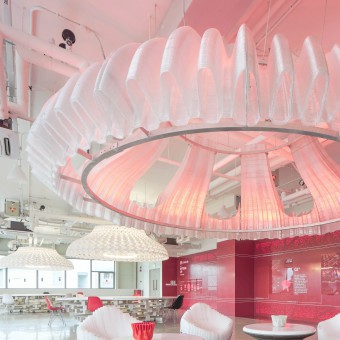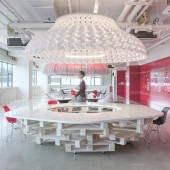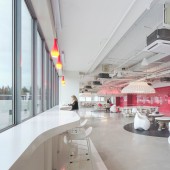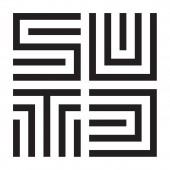DB Schenker Upcycling Hub Lunchroom by Carlos Banon |
Home > Winners > #150269 |
 |
|
||||
| DESIGN DETAILS | |||||
| DESIGN NAME: DB Schenker Upcycling Hub PRIMARY FUNCTION: Lunchroom INSPIRATION: The Large Room's design embodies our commitment to sustainability and innovation. Drawing inspiration from nature's efficiency and resilience, we use cutting-edge technologies and repurposed materials to create unique, functional design elements. This approach transforms waste into striking features, highlighting the untapped potential of upcycling and setting a new standard for circularity in design, emphasizing our dedication to a sustainable future. UNIQUE PROPERTIES / PROJECT DESCRIPTION: The Large Room revolutionizes waste repurposing by employing additive manufacturing to create stunning design elements from 500+ kg of single-use plastics. Utilizing advanced 3D printing, waste was transformed into functional, eye-catching features like a chandelier of 3D-printed tiles. This Upcycling Hub elevates circularity, inspiring businesses to adopt innovative waste management, setting a new precedent in sustainable design excellence. OPERATION / FLOW / INTERACTION: Utilizing waste materials like cardboard, foam, and plastic bottles, the Upcycling Hub transforms them into luxurious, functional designs. Through innovative processes, visitors experience waste in a new light, reimagining its potential in elegant and practical applications, emphasizing the harmony of sustainability and luxury. PROJECT DURATION AND LOCATION: The project started in August 2019 and finished in May 2022. It is located in Singapore's Red Lion Building. |
PRODUCTION / REALIZATION TECHNOLOGY: - 3D Printing from bespoke filament 100% from transparent PET bottles. - Polystyrene foam from packaging. - Cardboard from logistic boxes. - Discarded wooden pallets. - Recycled rubber flooring. SPECIFICATIONS / TECHNICAL PROPERTIES: 400 sqm. TAGS: Circularity, 3D Printing, Waste, Digital Design, Additive Manufacturing, Resource Efficient, Interior Design RESEARCH ABSTRACT: The DB Schenker Upcycling Hub explores innovative repurposing of waste materials through 3D printing and digital design. This exploratory research combines design thinking, experimentation, and prototyping. Results include a 5,000 sqft space showcasing waste materials' potential as functional design elements. The impact sets new circularity standards in logistics, inspires sustainable practices, and demonstrates 3D printing's capacity to transform waste into intricate designs. CHALLENGE: The hardest part of the DB Schenker Upcycling Hub was to create elegant design elements from waste. The challenge was overcome by leveraging 3D printing and digital design processes. Internal factors such as the need to change waste perceptions were considered. The team experimented with materials and technology to achieve beautiful and functional elements while complying with safety regulations. The result was a stunning Upcycling Hub that sets a new standard for circularity. ADDED DATE: 2023-03-02 02:23:53 TEAM MEMBERS (1) : Carlos Banon IMAGE CREDITS: Fabian Ong |
||||
| Visit the following page to learn more: https://tinyurl.com/2aand78n | |||||
| AWARD DETAILS | |
 |
Db Schenker Upcycling Hub Lunchroom by Carlos Banon is Winner in 3D Printed Forms and Products Design Category, 2022 - 2023.· Press Members: Login or Register to request an exclusive interview with Carlos Banon. · Click here to register inorder to view the profile and other works by Carlos Banon. |
| SOCIAL |
| + Add to Likes / Favorites | Send to My Email | Comment | Testimonials | View Press-Release | Press Kit |







